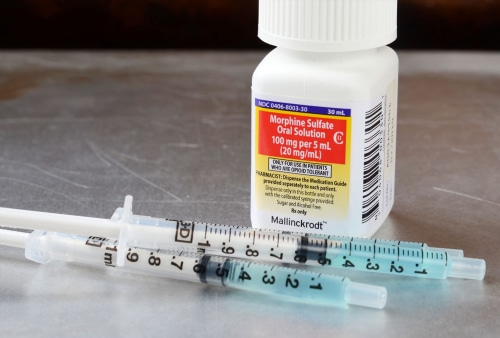Morphine Addiction and Treatment
In the early 19th century the commercial production of morphine was introduced for pain relief. When it was first created, it was praised as a useful tool for opium addiction, but then eventually was discovered to be more addictive than opium. It is now a country-wide known stat that it is one of the most prescription drugs.
What Is Morphine?
Morphine is one of the most powerful opioids that is originally derived from the opium found in the poppy plant. It is standard for any pain medication, blocks pain receptors in the brain and also calms the central nervous system. Morphine slows blood pressure, heart rate, and respiration to give a sense of pleasure and calm. Many feel it gives off a dream-like sensation, it is an overall euphoric feeling for the user.
Categorized as a schedule II drug, Morphine is prescribed for around-the-clock pain. We see morphine commonly used in cancer-related pain and post-surgery pain. This is a substance that has extremely high addiction rates because of how easily accessible it can be and the feeling of euphoria from use.
Morphine History
Originating in Asia because of where the poppy plant originally came from, opium has been a popular plant ever since humans discovered the medicinal and recreational effects. America was first introduced to the opium drug during the industrial age when many people moved from Asia to America, opium was already a popular drug in Asia at this time. Usage of opium as a pain reliever and recreational use, and addiction rose dramatically in the 18th and 19th centuries.
Morphine was originally developed by Friedrich Wilhelm Serturner between the years of 1805-1816, after testing on himself- he discovered the compound to relieve pain and gave a euphoria. He named morphine after the Greek god of dreams, Morpheus. By the mid 1800s, morphine was produced commercially and was a “miracle drug” praised by Doctors who used it during the American Civil War for injured soldiers. However, after the war was over, it was known that many of the soldiers on morphine had developed a morphine addiction.
The first hypodermic needle was invented in 1853, and now gave users a whole new way to introduce morphine directly into the bloodstream. Now that morphine was refined, the drug was 10 times more effective for treatment of pain relieve than opium ever was. The new variation of opium was also highly more addictive. Its addictive properties also turned out to be exponentially enhanced, the new challenge now, morphine addiction.
What Does Morphine Look Like?
Morphine sulfate pills are manufactured in different shapes, sizes and colors. Regardless of shape or color, one common feature of all morphine sulfate tablets is that they must indicate their dosage content in milligrams on the top/front of the tablet. Morphine also comes in liquid form for IVs.
Morphine Street and Brand Names
Below are the common brand names under which morphine is produced and marketed are:
Morphabond
Roxanol
Morphine Sulfate ER
Kadian ER
MS Contin
Embeda
“Street terms” or “street names” that are commonly used in reference to morphine include:
TNT
Tango and Cash
Dreamer
White Stuff
Aunti Em
Aunti
Dance Fever
Murder 8
Goodfella
Monkey
Morph
Drone
Morphine Dosage
Each person will have a variation to dosage but just as any other drug each individual will have the recommended dosage while taking morphine, and this is provided by their doctor. The dosage will remain different for each person taking the drug, based on need and pain level. Typically, for administration of the immediate-release morphine sulfate tablets, this will happen every four hours and ranges from 15mg to 30mg dose. Everyone taking morphine should know the fatal effects that a morphine overdose can have on an individual. Federally designated as a Schedule II drug, so taking this substance should be overseen by professional medical care, it carries a high risk of developing reliance, dependence or even a full blown morphine addiction.
Morphine Addiction
Morphine is an extremely addictive substance, categorized as a Schedule II substance under the by the United States Drug Enforcement Administration (DEA) under the Department of Justice. Any schedule II drug has the characteristics of having high rates of abuse for the substances on the schedule II list. ” For this reason, morphine should be taken strictly under prescription. Even then, close supervision by a medical doctor is required as the risk of developing dependence is still present. The risk of developing morphine addiction and dependence is so high that it does not require prolonged use. Morphine addiction can develop within the first few times of taking the drug in any form.
According to SAMHSA, in the recent past years, over 50% of accidental overdoses can be attributed to morphine and heroin (opioids). Unfortunately, moving forward, all indicators point to even greater numbers in morphine addiction in the current times.
Treatment For Morphine Addiction
If you or someone you know is addicted to morphine, there is hope and help. Morphine must be tapered off the medication by a professional medical doctor. Quitting cold turkey has many dangers if you are not consulting with your doctor first. Consult with your primary care doctor or physician about a lower dose of morphine in order to properly taper from the strong opioid. After the initial detox process the next levels of care would be a partial hospitalization or an intensive outpatient treatment program.
The PHP and IOP levels of care provided by The Best Treatment is important because in order to prevent relapse it is suggested a 60-90 day rehabilitation process is completed. We offer an individualized treatment program because it is essential to begin treating the root causes of drug use and addiction and everyone’s care is different.
Our goal here at The Best Treatment Center is to support our guests during their recovery journey and always encourage their continuous growth.

